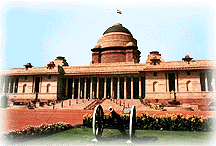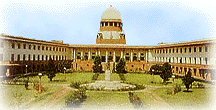|
|
|
Federal System
India,
a union of states, is a Sovereign, Secular, Democratic
Republic with a Parliamentary system of Government. The
Indian polity is governed in terms of the Constitution,
which was adopted by the Constituent Assembly on 26
November 1949 and came into force on 26 January 1950.
The President is the constitutional head of Executive of the
Union. Real executive power vests in a Council of
Ministers with the Prime Minister as head. Article 74(1)
of the Constitution provides that there shall be a Council
of Ministers headed by the Prime Minister to aid and
advise the President who shall, in exercise of his
functions, act in accordance with such advice. The Council
of Ministers is collectively responsible to the Lok Sabha,
the House of People.
In the states, the Governor, as the representative of the
President, is the head of Executive, but real executive
power rests with the Chief Minister who heads the Council
of Ministers. The Council of Ministers of a state is
collectively responsible to the elected legislative
assembly of the state.
The Constitution governs the sharing of legislative power
between Parliament and the State Legislatures, and
provides for the vesting of residual powers in Parliament.
The power to amend the Constitution also vests in
Parliament.
The Union Executive consists of the President, the
Vice-President and Council of Ministers with the Prime
Minister as the head to aid and advise the President.
|
|
President
The
President is elected by members of an Electoral College
consisting of elected members of both Houses of Parliament
and Legislative Assemblies of the states, with suitable
weightage given to each vote. His term of office is five
years.
Among
other powers, the President can proclaim an emergency in
the country if he is satisfied that the security of the
country or of any part of its territory is threatened
whether by war or external aggression or armed rebellion.
When there is a failure of the constitutional machinery in
a state, he can assume to himself all or any of the
functions of the government of that state.
|
 |
|
Vice-President
The Vice-President is elected by the members of an electoral
college consisting of members of both Houses of Parliament
in accordance with the system of proportional
representation by means of a single transferable vote. He
holds office for five years. The Vice-President is the
Ex-officio Chairman of Rajya Sabha.
Council of Ministers
The Council of Ministers comprises Cabinet Ministers,
Minister of States (independent charge or otherwise) and
Deputy Ministers. Prime Minister communicates all
decisions of the Council of Ministers relating to
administration of affairs of the Union and proposals for legislation to the President. Generally,
each department has an officer designated as secretary to
the Government of India to advise Ministers on policy
matters and general administration. The Cabinet
Secretariat has an important coordinating role in decision
making at highest level and operates under direction of
Prime Minister.
The Legislative Arm of the Union,
called Parliament, consists of the President, Rajya Sabha
and Lok Sabha. All legislation requires consent of both
houses of parliament. However, in case of money bills, the
will of the Lok Sabha always prevails.
Rajya Sabha
The Rajya Sabha consists of 245 members. Of these, 233
represent states and union territories and 12 members are
nominated by the President. Elections to the Rajya Sabha
are indirect; members are elected by the elected members
of Legislative Assemblies of the concerned states. The
Rajya Sabha is not subject to dissolution, one third of
its members retire every two year.
|
|
Lok Sabha
|
The Lok Sabha is composed of representatives of the people
chosen by direct election on the basis of universal
adult suffrage. As of today, the Lok Sabha consists of
545 members with two members nominated by the
President to represent the Anglo-Indian Community.
Unless dissolved under unusual circumstances, the term
of the Lok Sabha is five years |
 |
State Governments
The system of government in states closely resembles that of
the Union.
There are 25 states and seven Union territories in the
country.
Union
Territories are administered by the President through an
Administrator appointed by him. Till 1 February 1992, the
Union Territory of Delhi was governed by the Central
government through an Administrator appointed by the
President of India. Through a Constitutional amendment in
Parliament, the Union Territory of Delhi is now called the
National Capital Territory of Delhi from 1 February 1992.
General elections to the Legislative assembly of the
National Capital Territory were held in November 1993.
Political System
A recognised political party has been classified as a
National Party or a State Party. If a political party is
recognised in four or more states, it is considered as a
National Party.
The Congress, Bharatiya Janata Party, Janata Dal, Communist
Party of India and Communist Party of India (Marxist) are
the prominent National Parties in the Country. Telugu
Desam in Andhra Pradesh, Asom Gana Parishad in Assam,
Jharkhand Mukti Morcha in Bihar, Maharashtrwad Gomantak
Party in Goa, National Conference in Jammu and Kashmir,
Muslim League in Kerala, Shiv Sena in Maharashtra, Akali
Dal in Punjab, All-India Anna Dravida Munnetra Kazhagam
and Dravida Munnetra Kazhagam in Tamil Nadu, Bahujan Samaj
Party and Samajwadi Party in Uttar Pradesh and All-India
Forward Block in West Bengal are the prominent state
parties.
Eleven Lok Sabhas have been constituted so far. Except for
the short-lived Sixth and Ninth Lok Sabha, the Congress
Party ruled the country. The Sixth Lok Sabha functioned
for about two years and four months and the Ninth Lok
Sabha functioned for one year and two months.
Even in the states, the regional parties or the non-congress
parties have gained in importance over the years. The
ruling parties in the states are listed below.
|
 |
|
Judicial System
The Supreme Court is the apex court in the country. The High
Court stands at the head of the state's judicial
administration. Each state is divided into judicial
districts presided over by a district and sessions judge,
who is the highest judicial authority in a district. Below
him, there are courts of civil jurisdiction, known in
different states as munsifs, sub-judges, civil judges and
the like. Similarly, criminal judiciary comprises chief
judicial magistrate and judicial magistrates of first and
second class.
Supreme Court
The Supreme Court has original, appellate and advisory
jurisdiction. Its exclusive original jurisdiction extends
to all disputes between the Union and
one or more states or between two or more states. The
Constitution gives an extensive original jurisdiction to
the Supreme Court to enforce Fundamental Rights.
|
|
Appellate jurisdiction of the Supreme Court can be invoked by
a certificate of the High Court concerned or by special
leave granted by the Supreme Court in respect of any
judgement, decree or final order of a High Court in cases
both civil and criminal, involving substantial questions
of law as to the interpretation of the constitution. The
President may consult the Supreme Court on any question of
fact or law of public importance.
The Supreme Court of India comprises of the Chief Justice and
not more than 25 other Judges appointed by the President.
Judges hold office till 65 years of age.
|
 |
|
High Courts
There are 18 High Courts in the country, three having
jurisdiction over more than one state. Bombay High Court
has the jurisdiction over
Maharashtra, Goa, Dadra and Nagar Haveli and Daman and Diu.
Guwahati High Court, which was earlier known as Assam High
Court, has the jurisdiction over Assam, Manipur, Meghalaya,
Nagaland, Tripura, Mizoram and Arunachal Pradesh. Punjab
and Haryana High Court has the jurisdiction over Punjab, Haryana and Chandigarh.
Among the Union
Territories, Delhi alone has had a High Court of its own.
The other six Union Territories
come under jurisdiction of different state High Courts.
The Chief Justice of a High Court is appointed by the
President in consultation with the Chief Justice of India
and the Governor of the state. Each High Court has powers
of superintendence over all courts within its
jurisdiction. High Court judges retire at the age of 62.
The jurisdiction as well as the laws administered by a High
Court can be altered both by the Union and State Legislatures. Certain High Courts, like those at
Bombay, Calcutta and Madras, have original and appellate
jurisdictions. Under the original jurisdiction suits,
where the subject matter is valued at Rs.25,000 or more,
can be filed directly in the High Court. Most High Courts
have only appellate jurisdiction.
Lok Adalat
Lok Adalats are voluntary agencies for resolution of disputes
through conciliatory method.
Legislative Relations Between the Union and
States
Under the Constitution, Parliament has the power to create
laws for the whole or any part of the territory
of India. The State Legislatures have the power to make
laws for the States. The subjects on which legislation can
be enacted are specified in the Seventh Schedule of the
Constitution.
Parliament has the exclusive right to legislate in respect of
items appearing in List I, called the "Union List''. This
list includes area such as defence, foreign affairs,
currency, income tax, excise duty, railways, shipping,
posts and telegraphs, etc.
State Legislatures have the exclusive power to make laws in
relation to items appearing in List II called the "State
List''. This includes items like public order, police,
public health, communications, agriculture, lotteries,
taxes on entertainment and wealth, sales tax and octroi,
etc.
Both Parliament and the State Legislatures have the power to
legislate in items appearing in List III of the
Constitution which is known as "Concurrent List''. This
list includes items like electricity, newspapers, criminal
law, marriage and divorce, stamp duties, trade unions,
price controls, etc.

|
|